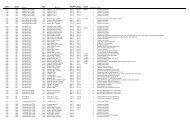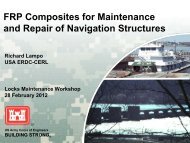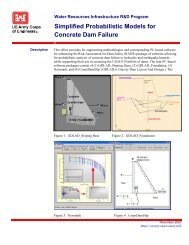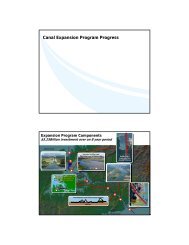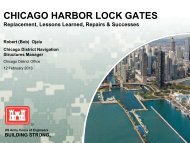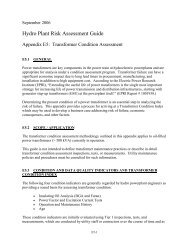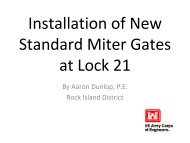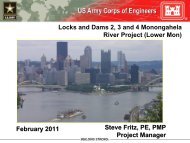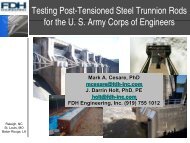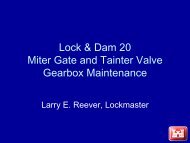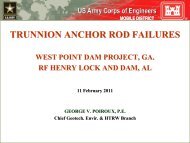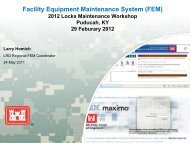Hydro Plant Risk Assessment Guide
Hydro Plant Risk Assessment Guide
Hydro Plant Risk Assessment Guide
You also want an ePaper? Increase the reach of your titles
YUMPU automatically turns print PDFs into web optimized ePapers that Google loves.
extensive wearing.<br />
Extreme – Brake does not release, or is not able to hold load (slips). Subtract 1.5<br />
Test T2.3.14: Electrical Operators – Wire Ropes and Chains<br />
Wire ropes and chain carry the load of emergency closure gates and must be in serviceable<br />
condition. Failure or these devices could cause significant economic and life safety impact.<br />
Hoists that are difficult to inspect often are not. It is important to examine the entire length of<br />
wire rope, especially the underside of the rope that commonly comes in contact with the hoist<br />
drum or sheaves as the top of the rope can be in good condition while the bottom side can be<br />
severely worn. Other problems with wire rope include, but are not limited to: corrosion (loss of<br />
cross-sectional area) and broken wires, strands, and cores from abrasion, fatigue, deformation,<br />
and material defect.<br />
Traditionally, tests have been visual, but there is now a non-destructive test method called<br />
Magnetic Flux Leakage (MFL) test that can be performed on wire rope that will reveal<br />
deficiencies not easily identified by visual inspections. MFL may be justified for critical<br />
applications such as emergency closures.<br />
Hoist chain is difficult to inspect and is not usually cost effective (if thought to be defective) as it<br />
can be easily replaced relatively inexpensively.<br />
Table 36 – Wire Ropes and Chains<br />
Results<br />
Good – Wire rope in good condition with no significant loss in<br />
cross-sectional area, no broken wires, corrosion is superficial.<br />
Rope greased sufficiently. Chain in good condition; withstands<br />
proof loads.<br />
Moderate – Less than 12 randomly broken wires in one lay and/or <<br />
4 broken wires in one strand in one lay. Less than 1/3 diameter loss<br />
from wear or corrosion in outside individual wires and/or < 10%<br />
loss in cross-sectional area at any point in rope. No crushing or<br />
kinking. Chain in marginal condition with < 10% loss in crosssectional<br />
area; withstands proof loads. Wire ropes or chains<br />
should be replaced as soon as reasonably possible.<br />
Severe – 12 or more randomly broken wires in one lay and/or ≥ 4<br />
broken wires in one strand in one lay. 1/3 or more diameter loss<br />
from wear or corrosion in outside individual wires and/or ≥ 10%<br />
loss in cross-sectional area at any point in rope. Wire crushed or<br />
kinked; evidence of heat damage. Chain in poor condition with ≥<br />
10% loss in cross-sectional area. Wire ropes or chains should be<br />
changed immediately before emergency closure is used.<br />
Adjustment to<br />
Condition Index Score<br />
No Change<br />
Subtract 0.5<br />
Subtract 1.0<br />
E11-31



